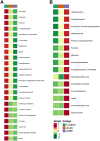Immune and physiological responses in Penaeus monodon to ammonia-N stress: a multi-omics approach
- PMID: 39720717
- PMCID: PMC11666502
- DOI: 10.3389/fimmu.2024.1510887
Immune and physiological responses in Penaeus monodon to ammonia-N stress: a multi-omics approach
Abstract
Ammonia-N stress is a significant environmental factor that adversely affects the health and productivity of aquaculture species. This study investigates the effects of ammonia-N stress on the shrimp Penaeus monodon through a combination of biochemical, histological, transcriptomic, and metabolomic analyses. Shrimp were exposed to ammonia-N stress for 12 and 96 hours, and key markers of oxidative stress, nitrogen metabolism, immune response, and overall health were assessed. The results showed that prolonged ammonia-N exposure causes significant hepatopancreatic damage, including atrophy and deformation. Transcriptomic analysis revealed significant changes in gene expression related to apoptosis, immune response, and key metabolic pathways, with particular emphasis on the disruption of innate immune signaling and defense mechanisms. Metabolomic analysis identified disruptions in nucleotide turnover, antioxidant defenses, and fundamental metabolic processes. These findings suggest that ammonia-N stress induces a multifaceted stress response in shrimp, involving oxidative stress, immune activation, and metabolic disturbances. Understanding these immune-related and metabolic mechanisms provides valuable insights into the molecular responses of crustaceans to environmental stress, laying the foundation for assessing the ecological risk of ammonia-N and identifying potential immunological biomarkers for monitoring and mitigating its adverse effects in aquaculture systems.
Keywords: ammonia-N stress; immune response; metabolome; oxidative stress; shrimp; transcriptome.
Copyright © 2024 Luo, Zhou, Jiang, Huang, Yang, Yang, Shi, Li, Ma and Li.
Conflict of interest statement
The authors declare that the research was conducted in the absence of any commercial or financial relationships that could be construed as a potential conflict of interest.
Figures







Similar articles
-
Multi-omics insights into antioxidant and immune responses in Penaeus monodon under ammonia-N, low salinity, and combined stress.Ecotoxicol Environ Saf. 2025 Apr 15;295:118156. doi: 10.1016/j.ecoenv.2025.118156. Epub 2025 Apr 6. Ecotoxicol Environ Saf. 2025. PMID: 40188731
-
Transcriptome reveals involvement of immune defense, oxidative imbalance, and apoptosis in ammonia-stress response of the black tiger shrimp (Penaeus monodon).Fish Shellfish Immunol. 2018 Dec;83:162-170. doi: 10.1016/j.fsi.2018.09.026. Epub 2018 Sep 8. Fish Shellfish Immunol. 2018. PMID: 30205201
-
Characterization and expression analysis of a chitinase gene (PmChi-4) from black tiger shrimp (Penaeus monodon) under pathogen infection and ambient ammonia nitrogen stress.Fish Shellfish Immunol. 2017 Mar;62:31-40. doi: 10.1016/j.fsi.2017.01.012. Epub 2017 Jan 9. Fish Shellfish Immunol. 2017. PMID: 28089896
-
Single-Cell Sequencing Reveals Types of Hepatopancreatic Cells and Haemocytes in Black Tiger Shrimp (Penaeus monodon) and Their Molecular Responses to Ammonia Stress.Front Immunol. 2022 May 4;13:883043. doi: 10.3389/fimmu.2022.883043. eCollection 2022. Front Immunol. 2022. PMID: 35603188 Free PMC article.
-
The comprehensive expression analysis of the G protein-coupled receptor from Penaeus monodon indicating it participates in innate immunity and anti-ammonia nitrogen stress.Fish Shellfish Immunol. 2018 Apr;75:17-26. doi: 10.1016/j.fsi.2018.01.019. Epub 2018 Feb 2. Fish Shellfish Immunol. 2018. PMID: 29410275
Cited by
-
Veverimer, a Nonabsorbed Gastrointestinal Tract HCl Binder, Decreases Renal Ammoniagenesis and Mitigates Nephrotoxic Serum Nephritis.Kidney360. 2025 May 1;6(5):696-706. doi: 10.34067/KID.0000000743. Epub 2025 Mar 3. Kidney360. 2025. PMID: 40029708 Free PMC article.
-
Copper Pyrithione Induces Hepatopancreatic Apoptosis and Metabolic Disruption in Litopenaeus vannamei: Integrated Transcriptomic, Metabolomic, and Histopathological Analysis.Animals (Basel). 2025 Jul 18;15(14):2134. doi: 10.3390/ani15142134. Animals (Basel). 2025. PMID: 40723597 Free PMC article.
References
-
- F.a.A.O.o.t.U. Nations . The State of World Fisheries and Aquaculture 2016. Rome, Italy: FAO; (2016).
-
- Dewali S, Sharma N, Melkani D, Arya M, Kathayat N, Panda AK, et al. . Aquaculture: Contributions to Global Food Security. In: Ghosh S, Kumari Panda A, Jung C, Singh Bisht S, editors. Emerging Solutions in Sustainable Food and Nutrition Security. Springer International Publishing, Cham: (2023). p. 123–39.
-
- Anderson JL, Asche F, Garlock T, Chu J. Aquaculture: Its Role in the Future of Food. In: World Agricultural Resources and Food Security. Bingley, UK: Emerald Publishing Limited; (2017). p. 159–73.
MeSH terms
Substances
LinkOut - more resources
Full Text Sources

